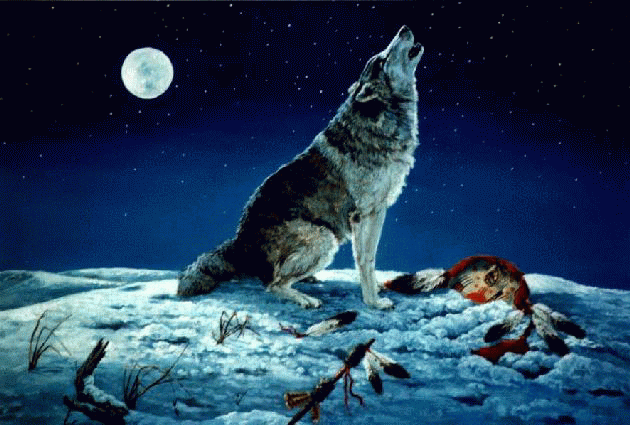
Wolves are shy, submissive animals. There has never been a documented case in North America where a healthy wolf has ever attacked a human.

Gray wolves are part of the Canidae (dog) family and display considerable intelligence and adaptability. Like some dogs, they are very territorial and will claim certain den sites, travel routes and feed grounds as their own.

Adult wolves have the ability to regulate their body temperatures and can, therefore, adapt to different climates. Very young pups, however, cannot regulate their body temperatures and must stay close to their mother for warmth.

Wolves from the Arctic Tundra are usually white and have long, thick fur to protect them from the cold. In unusually frigid weather, they will find shelter in a den or cave.

The wolf is a very social animal and depends on pack cooperation for it's survival. All members of the pack have a definite role, be it an alpha position or subordinate. Once the wolf pups are weaned, the "aunts" and "uncles" of the pack play an important role in their upbringing; supplying them with food and recreation.

Wolves seldom bark, but when they do it is a quiet, quick bark and not continuous like some dogs. Many times a bark is prompted when a stranger approaches or they are taken by surprise.

The wolf's coat consists of 2 layers; a soft, dense undercoat that is light in color, and long coarse guard hairs that shed moisture keeping the undercoat dry. Most of the undercoat and some of the guard hairs are shed in the spring and grow back in the fall.

When wolf cubs are about 2 weeks old, their eyes and ears open. Their eyes are a deep blue and will begin to change to brown or yellow/amber by the time they are 8 weeks old. A pup can eat more than 2 pounds of food daily which keeps the adult wolves busy hunting for food.

Wolf pups are born in a den that has been selected by the mother. If one is not available, she will dig her own. The gestation period is usually 63 days. The babies are born deaf and blind and remain so until their eyes and ears open, usually about 14 days after they are born.

The Gray Wolf (Canis lupus) has a very distinct howl that can be heard from up to 10 miles away. Howling is a form of communication used to reunite their pack, to greet other wolves, mark their territory or for pure enjoyment.

The wolf's mouth is its best hunting tool. A wolf has 42 elongated teeth and its jaws can crush up to 1,500 pounds. A wolf's coat has a large range of colors from almost pure white to varying shades of blonde, cream, gray, brow n and black. The thickness of their pelt varies according to the region they live in.

Wolves usually live in packs from 5 to 8 members, but can be as small as 2 or 3 or as large as 15 to 20. There is a dominant male (leader of the pack) and a dominant female. They are the only ones in the pack who breed, having one litter a year. Babies are born in the spring. Litter size can range from 1 to 14 pups with 4 to 6 pups being the average size. Wolf People
Please Visit My Friends
Home
Page
Hawk Flying
Faithwalker
Kentucky Cherokee
Time Traveler
Heartland Ranch
Tsalagi History
Legacy of Love Tsalagi Traditions
Legend
Lodge
History
part 1
History
Part 2
Trail of Tears
John Burnett
John
Ross
Seqouyah
Eternal Flame
Nancy ward
Tsalagi
Moons
Seven
Clans
Prayers
ale Poetry
Wolves
Tsalagi Recipes
Gathering of Crops
Games
Writings of Three Feather
View
what others have spoken
Awards My Site Has Been Bestowed